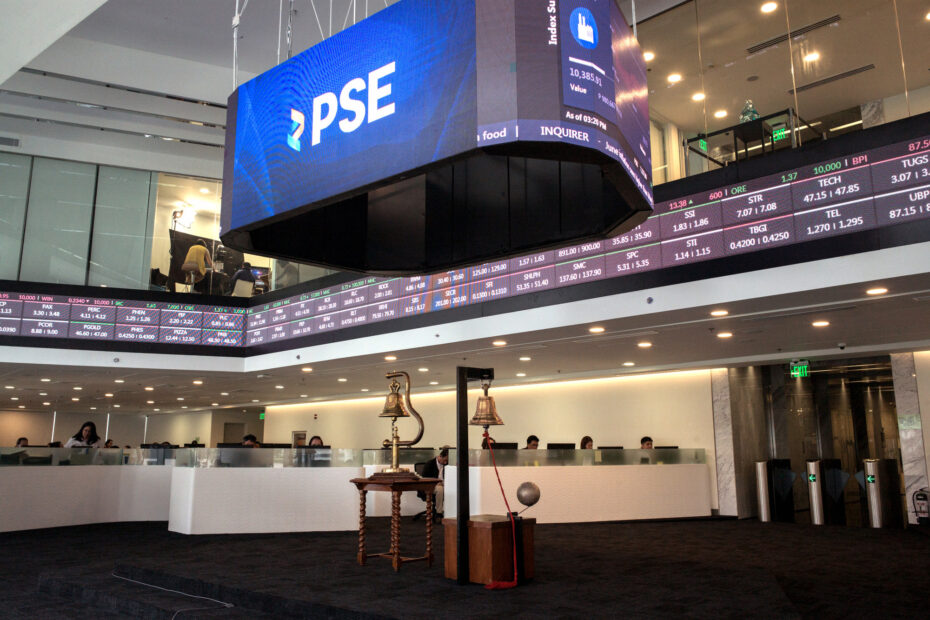THE MARKET SUMMARY
After the robust rally in the final quarter of 2023, the performance of various asset classes in January presented a mixed picture. The buoyancy of risk assets was fueled by strong growth data and hopes for a “soft landing” in the US, but this optimism was tempered towards the end of the month when the Federal Reserve struck a less dovish tone during its January meeting. Some central bankers pushing back on the market’s dovish outlook for rate cuts also contributed to a less favorable environment.
In the Philippines, the full-year growth target was missed as the economy lost momentum in the last quarter of the year. A contraction in government spending offset a slight rebound in domestic demand, resulting in a fourth-quarter GDP expansion of 5.6%, exceeding expectations but slower than the previous quarter’s 6.0% growth. The full-year growth of 5.58% fell below the government’s target but still positioned the country as one of the fastest-growing economies in Asia.
Notably, growth stocks outperformed their value counterparts, and commodities, particularly oil, experienced a rally driven by worsening tensions in the Middle East and disruptions to shipping through the Suez Canal. Drone attacks on Russian energy infrastructure added layer of uncertainty to the global oil market.
Real estate investment trusts and small caps, both sensitive to interest rates, faced challenges as markets scaled back expectations for the magnitude of rate cuts by central banks in 2024.
In the aftermath of the excitement at the close of the previous year, January delivered mixed results for investors. Initially boosted by the strength of recent activity data, equity markets saw a pullback in performance due to the more hawkish tone at the Federal Reserve’s January meeting. Bond markets experienced volatility, as strong growth data did not fully justify the previously priced-in magnitude of rate cuts. Despite this recent re-pricing, there is still a high level of confidence in core bonds, valued for their income potential and diversification benefits. Should the economy’s resilience wane, bonds are expected to play a crucial role in maintaining a well-diversified portfolio.
THE STORIES THAT SHAPED THE MARKET
The Philippines’ gross domestic product (GDP) growth fell to 5.58% in 2023 – below the government target of 6-7%.
The full-year GDP growth for 2023 is much lower than the 7.6% notched in 2022, which made the Philippines the fastest-growing economy in Southeast Asia that year.
The Philippine Statistics Authority also reported on January 31, that fourth quarter growth for 2023 was at 5.6%. In the same quarter in 2022, growth reached 7.1%.
The country’s GDP growth of 5.9% in the third quarter of 2023 had been the fastest in the region, driven by a surge in government spending that compensated for slower domestic consumption.
Despite economic growth missing the government’s target, the Philippines remains one of the best-performing economies in Asia, among those that have already released their fourth-quarter figures.
Growth for the year had to contend with rising prices as average inflation for 2023 hit 6%, far above the 2-4% target of the government.
In response, the Philippine central bank has taken a hawkish stance. But though rate hikes can be a tool to bring inflation under control, economists warned that excessive hikes could affect GDP growth as consumers and businesses find it more expensive to borrow money.
Among major industries, services-led growth for the full year 2023 at 7.2%, while industry grew by 3.6% and agriculture, forestry, and fishing by 1.2%.
Similarly, services contributed the most to the 5.6% GDP figure, with it responsible for 4.4 percentage points. Industry contributed 1.1 percentage points while agriculture, forestry, and fishing contributed just 0.1 percentage points.
Meanwhile, government spending contracted by 1.8% in the fourth quarter after growing by 6.7% in the third quarter. Recall that government spending shrank by 7.1% in the second quarter as well. Because of the underspending, government expenditures grew by only 0.4%.
Government spending is a crucial component of economic growth. However, the limited growth in government spending is partly intentional, with the government wanting to achieve fiscal consolidation, which means lowering the fiscal deficit and government debt.
Although the economy didn’t grow as fast as the government expected it to in 2023, National Economic and Development Authority Secretary Arsenio Balisacan said it has to be assessed against the backdrop of the country’s pandemic recovery.
Since shrinking by 9.5% in 2020, the Philippine economy is now 8.6% higher than pre-pandemic levels.
The economy had to grow at least 7.4% in the fourth quarter to hit the low end of the 6% to 7% target set by President
Ferdinand Marcos Jr.’s economic managers, according to the Department of Finance (DOF).
Back in November when the third-quarter figure was released, the DOF remained firm that the country would end the year close to its growth targets.
Earlier, the Asian Development Bank also lowered its 2023 GDP growth forecast for the Philippines to 5.7%, which is below the government target, citing inflation worries.
For 2024, the economic team targets GDP to grow 6.5-7.5%.
December Inflation
Inflation slowed to 3.9% in December, settling within the central bank’s 2-4% target range for the first time in nearly two years, amid easing prices of food and utilities.
Preliminary data from the Philippine Statistics Authority (PSA) showed the overall year-on-year increase in prices of widely used goods and services eased to 3.9% in December, from 4.1% in November and 8.1% a year ago.
December’s inflation print was the slowest reading in 22 months since the 3% reading in February 2022.
The latest consumer price index (CPI) is a tad lower than the 4% median estimate in a poll last week. It also settled within the 3.6% to 4.4% forecast for the month given by the central bank.
However, inflation averaged 6% for 2023, slightly higher than the 5.8% in 2022. This marked the second straight year that inflation breached the central bank’s 2-4% target band.
The 6% print was the highest in 14 years or since the 8.2% full-year average in 2008, at the height of the global financial crisis.
The latest inflation outturn is consistent with the central bank’s projections that inflation will likely moderate in the near term due to easing supply-side price pressures and negative base effects.
Core inflation, which discounted volatile prices of food and fuel, stood at 4.4% percent in December – slower than the previous month’s 4.7% and the 6.9% a year earlier.
For the entire year, core inflation averaged 6.6%, much faster than the 3.9% print in 2022.
The December inflation print was due mainly to the 1.5% growth in prices of housing, water, electricity, gas, and other fuels, which was slower than the 2.5% in November.
This was followed by the 5.4% rise in the food and non-alcoholic beverages index, easing from 5.7% in November.
Food inflation alone went down to 5.5% in December, from 5.8% in November and 10.6% a year ago.
However, rice inflation quickened to 19.6% in December from 15.8% in November. It was also the most significant contributor to December inflation, adding 1.7 percentage points (ppt) to the headline print.
At 19.6%, rice inflation was the highest since the 22.9% recorded in March 2009.
The average price of regular milled rice last month went up to P48.50 per kilo from P46.73 per kilo in November. The average price of well-milled rice also rose to P53.82 per kilo in December from an average of P51.99 per kilo a month earlier.
Year on year, prices of regular milled rice and well-milled rice grew by 22.3% and 22.4%, respectively.
In a statement, the National Economic and Development Authority (NEDA) said the extension of Executive Order (EO) No. 50, which extended the Most Favored Nation (MFN) reduced tariff rates for key agricultural commodities like pork, corn, and rice, is crucial to ensure a stable food supply in the Philippines.
Meanwhile, transport inflation inched up 0.4% in December, a reversal from the 0.8% contraction in November. Passenger transport by road such as jeepneys and tricycle fares increased 2.9% in December from 2.4% a month prior.
Prices of diesel decreased by 13% year on year, but lower than the 18.4% decline in November. Gasoline also recorded a – 3.9% inflation rate from the -4.8% seen in the previous month.
In December alone, pump price adjustments stood at a net increase of P0.3 per liter for gasoline. Diesel and kerosene prices had a net decrease of P0.35 and P0.51 respectively.
Meanwhile, inflation for the bottom 30% of income households edged higher to 5% in December from 4.9% in a month prior.
Year to date, the inflation rate for this income group stood at 6.7%.
Inflation in the National Capital Region (NCR) decelerated to 3.5% in December from the 4.2% print in November and 7.6% a year ago.
Outside of NCR, consumer prices slowed to 4% from 4.1% in November and 8.2% in December 2022.
The central bank said risks to the inflation outlook remain significantly on the upside, citing possible inflationary pressures from higher transport charges, increased electricity rates, rising oil prices, and elevated food prices due to strong El Niño conditions.
Looking ahead, the Monetary Board deems it necessary to keep monetary policy settings sufficiently tight until a sustained downtrend in inflation becomes evident.
The central bank will continue to monitor inflation expectations and second-round effects and take appropriate action as needed to bring inflation back to the target, in keeping with the central bank’s price stability mandate.
Export prices of rice increased to $659 per metric ton amid lingering El Niño risks to supply.
Inflation may also quicken to above the 2-4% target in the second quarter due to unfavorable base effects.
But once these base effects wear off, we expect headline CPI to immediately ease on a year-on-year basis and average within 3-3.5% in the second half.
The central bank now has more legroom to adjust monetary policy with the inflation outlook more benign. The larger concern now is the differential between central bank and Fed rates.
The central bank has kept its benchmark interest rate unchanged at a 16-year high of 6.5% during its December policy meeting. This was after it hiked 450 basis points (bps) from May 2022 to October 2023 to tame inflation.
On the other hand, the US Federal Reserve kept borrowing costs unchanged at 5.25-5.5% in December, following the 525- bp rate hikes it did from March 2022 to July 2023.
Even though upside risks remain, inflation expectations are now better anchored.
The central bank is expected to maintain its policy rate through the first half of 2024, to help anchor inflation at around the mid-point of the policy target. Gradual rate cuts are expected from the third quarter onwards as inflation shows a steady declining trend.
Also, the central bank will likely maintain at least a 50-bp interest rate gap with the Fed to help ensure the peso’s stability against the dollar.
The Monetary Board is scheduled to have its first policy review this year on Feb. 15.
Rates to Stay Sufficiently Tight
The Philippine central bank is unlikely to cut borrowing costs at its meeting next month, as rates need to be sufficiently tight amid evolving risks to inflation, its governor said late Monday.
Central Bank Governor Eli M. Remolona, Jr. said a rate cut is unlikely on Feb. 15, the Monetary Board’s first policy review
this year, noting the risk-adjusted inflation forecast in 2024 is still above the 2-4% target.
The Monetary Board hiked borrowing costs by 450 basis points (bps) from May 2022 to October 2023, bringing the key interest rate to a 16-year high of 6.5% to tame inflation.
At the December meeting, the central bank’s risk-adjusted inflation forecast stood at 4.2% this year and 3.4% for 2025. Meanwhile, the central bank’s average inflation baseline forecast is 3.7% for 2024 and 3.2% for next year.
Rising tensions in the Red Sea and a prolonged El Niño weather episode are upside risks that are included in the risk-adjusted forecast, Central Bank Deputy Governor Francisco G. Dakila, Jr. said.
Houthi militants have continued to attack commercial shipping vessels traveling through the lower Red Sea since November last year.
Mr. Dakila noted El Niño is now expected to continue through the second quarter, instead of the first quarter as expected.
The state weather agency expects El Niño to persist until May this year. Earlier estimates by the central bank also showed that the dry weather event could raise inflation by 0.02 percentage points.
Mr. Remolona said inflation is projected to slow in January from 3.9% in December due to base effects, which could also drive inflation down in February or March.
Inflation peaked at 8.7% in January last year as food prices soared. It has since come down to a 22-month low in December.
For 2023, inflation averaged 6%, slightly higher than 5.8% in 2022. This marked the second straight year that inflation breached the central bank’s 2-4% target.
Despite base effects, inflation might remain elevated in the coming months due to external risks.
El Niño could lead to droughts and agricultural price hikes, which could push up inflation. Disruptions in the Red Sea may also increase import costs.
However, a weaker global demand could lead to lower commodity prices and dampen domestic demand. An improvement in the supply chain might also drive input costs lower, which could put downward pressure on inflation.
The projected economic slowdown in China could dampen the Philippines’ growth outlook this year, according to Mr. Remolona.
Mr. Remolona noted that China is one of the Philippines’ major trading partners and a good source of investments. The Philippines should diversify its trade and investment partners, he added.
A slowing Chinese economy could impact the economy via trade, investments, and tourism. The Philippines needs diversification strategies to mitigate its impact.
Reduced demand for Philippine exports, especially electronics, garments, and agricultural products would shrink the country’s economic pie. This slowdown could also disrupt supply chains, causing production bottlenecks and price hikes across various industries.
Based on data from the local statistics agency, the United States was the top destination of locally made products in November with a 16% share worth $1.14 billion. It was followed by Japan (13.2% share worth $938.3 million) and China (12.3% share valued at $876.27 million).
Meanwhile, China remained the Philippines’ main source of imported goods with a value of $2.6 billion, accounting for 24% of the total.
A potential decrease in Chinese foreign direct investment (FDI), which is crucial for infrastructure and tourism, could hamper economic growth and job creation. Capital flight from the region due to the slowdown might weaken the peso, further boosting import costs and fueling inflation.
Central bank data showed FDI inflows from China fell by 19.1% to $12.53 million as of October 2023 from $15.49 million a year ago.
Meanwhile, fewer Chinese tourists visiting the Philippines would affect local businesses and the hospitality industry.
Central Bank Governor Remolona assessed that the Philippines should diversify its trade and investment partners to mitigate the risks associated with a slowdown in China.
Diversification could involve focusing on other regional markets like Southeast Asia or the United States, developing domestic industries, and attracting investments from diverse sources.
ALI / AREIT
Ayala Land Inc. is shaving off a chunk of its stake in AREIT Inc. to ensure the real estate investment trust (REIT) arm remains compliant with public ownership requirements ahead of the group’s largest infusion of malls and industrial land worth over P28 billion.
Ayala Land and subsidiaries raised P5.63 billion from the sale of 181 million AREIT shares at a discounted price of P31.10 each.
AREIT will pay for the assets by issuing shares to Ayala Land and ACEN Corp. However the large size of the issuance is projected to cause AREIT to fall below the minimum 33% public ownership level required of REITs and could trigger a trading suspension.
Ayala Land said the shares were sold to various domestic and international investors, including qualified institutional buyers in the United States.
The transaction was upsized by over 40%, anchored by high-quality long-only institutional investors, Ayala Land said.
The share sale was arranged by BPI Capital Corp., UBS AG Singapore Branch, and CLSA Ltd. AREIT previously announced the planned infusion of Ayala Land projects worth nearly P22 billion.
These include Ayala Triangle Gardens Tower 2, luxury mall Greenbelt wings 3 and 5, and Holiday Inn and Suites in Makati, as well as Seda Hotel at Ayala Center Cebu. It is also taking over a 276-hectare industrial land in Zambales from ACEN for P6.8 billion.
MER / SPNEC
MGen Renewable Energy Inc. (MGreen), a subsidiary of Manila Electric Co., has completed its P15.9-billion investment in SP New Energy Corp. (SPNEC).
This, was after SPNEC was given the green light by the Securities and Exchange Commission (SEC) to raise its authorized capital stock from 50 billion to 75 billion common shares and 25 billion preferred shares.
SPNEC, the listed solar energy company founded by Leandro Leviste, issued 15.7 billion common shares and 19.4 billion preferred shares to MGreen, Meralco’s renewable energy development arm.
With the SEC’s approval and the issuance of these shares, the final conditions for MGreen’s investment have now been satisfied and MGreen is now the controlling shareholder of SPNEC with a total voting interest of 50.5%, SPNEC said in a disclosure.
The increase in capital stock also allows SPNEC to pursue further fundraising exercises, including a follow-on offering. Proceeds from MGreen’s investment would be used for the P200-billion Terra Solar Project.
With this transaction, Pangilinan was elected as chairman, president, and CEO of SPNEC with Leviste as vice-chairman.
SPNEC likewise appointed Amanda Roselle Bengson as director, chief compliance officer, and corporate secretary; Pedro Emilio Roxas as independent director; Dominador Camu Jr. as COO; Anthony Matthew Co as assistant treasurer and Jo Marianni Ocampo as assistant corporate secretary.
In May last year, MGreen announced that it was acquiring a controlling stake in SPNEC in line with efforts to build a renewable energy capacity of 1,500 megawatts by 2030.
MGreen plans to use SPNEC as the primary vehicle to develop 3,500 MW of solar panels and 4,000 megawatt-hours of battery energy storage systems in Luzon, seen as one of the largest solar projects not just in Asia, but in the world.
As the newest member of the MVP Group of Companies, SPNEC would be able to grow exponentially which in turn, will translate to shared benefits for its shareholders, Leviste said.
This Market Recap is provided by Globalinks Securities and Stocks Inc.
GTRADE – Trade Philippine Stocks Online




